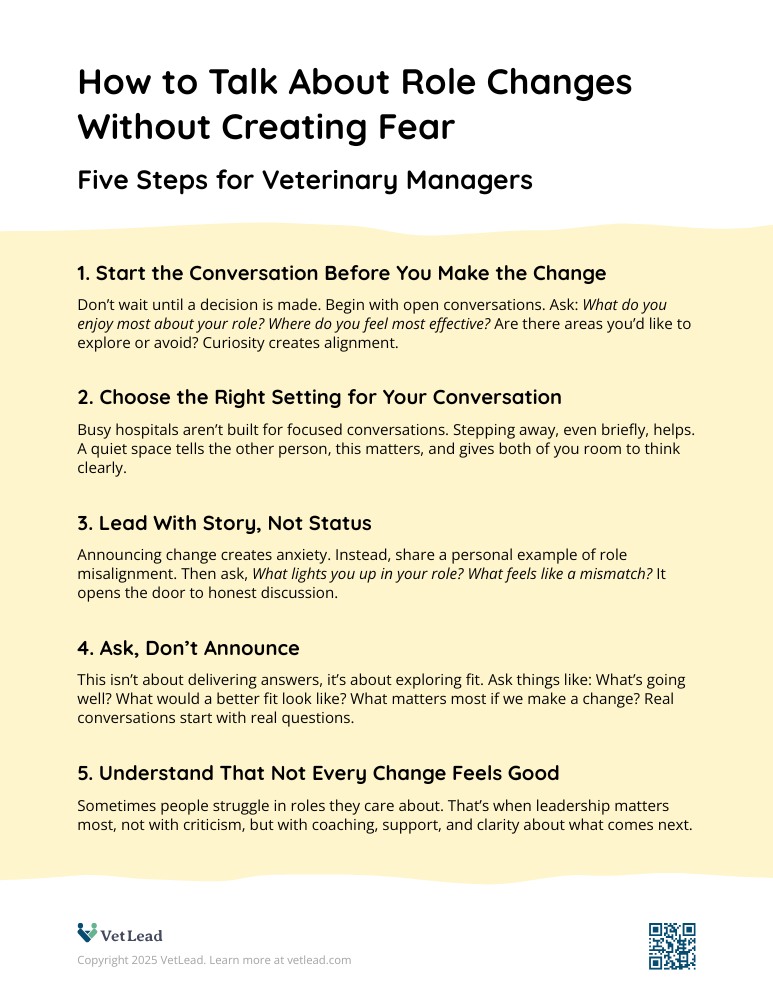Making changes to your team structure or roles in a veterinary practice isn’t easy. And if we’re honest, it’s often not the logistics that slow us down; it’s the conversation.
What will the team think?
Will they feel blindsided?
Will it seem like a demotion?
We get stuck, not because the change is wrong, but because we haven’t built the right process to talk about it. This is one of those moments where good leadership creates better outcomes. And it starts long before any changes are made.
Why Veterinary Managers Hesitate to Make the Right Team Changes
In most veterinary practices, people shift into roles because someone needed help, someone volunteered, or it just kind of happened. It wasn’t necessarily planned, aligned with their strengths, or something they were excited to grow into.
Sometimes we realize a change is needed. A team member might be in a role that isn’t the best fit, or a new structure could help the practice run more smoothly. But even when we know change is necessary, we hesitate.
We tell ourselves things like:
- “They’re going to be upset if I move them out of this role.”
- “I don’t want them to feel like they failed.”
- “It’s going to be a hard conversation, so I’ll deal with it later.”
But here's the part we often overlook: these conversations don’t have to be uncomfortable or damaging. In fact, when we approach them with clarity and care, they can lead to better alignment, stronger performance, and even greater job satisfaction.
So how do you do that in your practice?
Here are five steps to help you navigate role-change conversations in a way that supports your team, reduces fear, and leads to better outcomes for everyone involved.
Step 1: Start the Conversation Before You Make the Change
Leadership isn’t about making decisions behind closed doors and announcing them later. It’s about shaping the future with your team, not for them.
If you’re thinking about changing someone’s role, start by talking with them before any decisions are made. Ask questions that help them reflect, not defend:
- What parts of your job do you enjoy the most?
- Where do you feel you’re at your best?
- Are there areas in the practice that interest you more than what you’re doing now?
When we start with curiosity instead of conclusions, we create space for alignment. And often, we discover that the person is just as eager for a change, or at least open to exploring it.
Step 2: Choose the Right Setting for Your Conversation

Veterinary practices are noisy, not just audibly, but mentally as well. Phones ring. Patients need attention. Questions fly across treatment. None of it creates the calm needed for a meaningful conversation.
That’s why it often helps to step outside the hospital, even for a few minutes.
It’s not just about avoiding distractions. It’s about signaling that this conversation matters. It says, “I care about you, your future, and want to make time to talk about it the right way.”
Whether it’s a quiet table at a local café, a walk in the neighborhood, or even a private room away from the flow of the day, choosing a neutral, relaxed setting makes it easier for both of you to think clearly and speak honestly.
Step 3: Lead With Story, Not Status
If you start with, “We’re thinking of changing your role,” you’ve already put the other person on edge. Their brain will go into defense mode. Stress rises. Listening stops. Instead, start with a story. One that creates connection.
Here’s an example from a conversation I had with a practice owner:
“I love surgery, but I hate internal medicine. So I want to be called when that pet is asleep and stable under anesthesia, call me in and I can fix it. So if I were to walk in and to help a pet that is struggling with diabetes, that's going to break me into a cold sweat. Now I'll do everything I can to keep that thing alive. Then I'm also going to do everything I can to not be in that situation again.”
When you share your own experience, especially a vulnerable one like that, it shifts the entire tone of the conversation. You're not delivering bad news. You’re showing that everyone has strengths, preferences, and areas where they don’t do their best work. You're inviting reflection, not assigning blame.
That kind of honesty creates space for the other person to be just as open. And once you’ve shared, it’s a natural moment to ask a question that brings them into the conversation: “What’s something in your current role that lights you up? And what feels like a mismatch?”
That’s where the real conversation starts.
Step 4: Ask, Don’t Announce
People don’t need to be handled. They need to be heard. When we assume how someone will feel, or rush to explain what we’ve decided, we rob them of the chance to contribute to the solution.
Instead of announcing changes, ask questions that invite their input:
- “As we grow, I want to make sure you’re in a role where you feel like you’re thriving. Can we talk about how things are going and what might need to shift?”
- “What do you want to do more of? Less of?”
- “If we were to make changes, what would be important to you?”
These aren’t performance reviews; they’re leadership conversations. And when you have them early, with care and clarity, you avoid the fear that comes with surprise.
Step 5: Understand That Not Every Change Feels Good
Sometimes a conversation reveals something that’s hard to navigate, like when someone loves their role but isn’t effective in it, or when they’re struggling but don’t see it yet.
That doesn’t mean the process failed. It means the conversation worked.
These moments give you the opportunity to offer support, development, or transition, instead of continuing to operate in a way that doesn’t serve the practice or the individual.
And they’re rare. Most of the time, people appreciate the chance to talk openly and shape their path forward. But we don’t get to those outcomes if we avoid the conversation.

How to Talk About Role Changes Without Creating Fear
Download and share with leaders and teams. No email address required.
Moving Forward Without Fear in Your Veterinary Practice
Role changes don’t have to feel like punishments. They don’t have to be scary for you or your team. And they don’t have to come with tension or confusion.
When done well, they are moments of alignment, where the practice gets stronger and the team member feels seen, heard, and supported.
So if you’re facing a potential change in your practice structure or team roles, don’t wait for the perfect moment. Create it.
- Talk early.
- Ask questions.
- Lead with care and clarity.
The best veterinary practices aren’t just full of smart people. They’re full of people doing the work they’re best suited for, and leaders who help them get there.
What do you think? Other veterinary pros want to hear from you! Share your experience in the comments below.